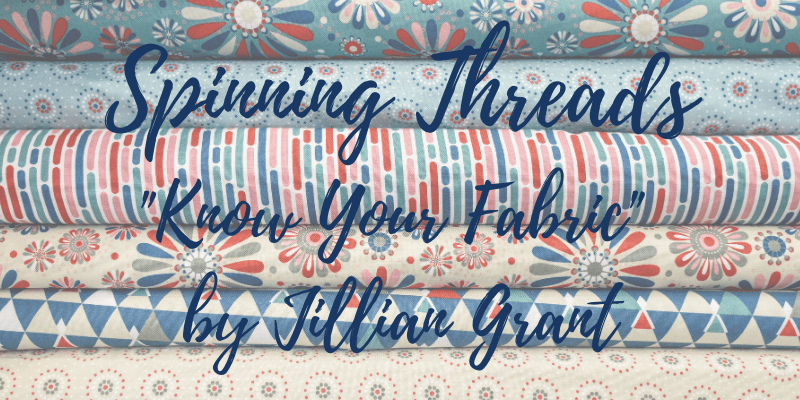By Jillian Grant
Do you have a special quilt project you are planning for a wedding, a baby shower or just a special gift? Before you plan your next quilt, here is some information about the differences in fabrics that may help to maximize the outcome of that project. Most quilters pour their heart, soul and hard-earned money into making their work of art and love. Because of the availability of resources today, it only makes sense to get the most out of all your efforts. The best-laid plans of a quilter could be sabotaged by a lack of knowledge about the resources to be used.
First, a quilter needs to know about the different types of fabric/textiles available. Not all fabric is equal. Due to manufacturing processes, types of raw materials used, and cost involved, there can be a wide fluctuation in the types of materials available. Of course, we will assume we are only talking about using 100% cotton fabric for the quilt. Here are a few considerations:
Novelty Fabrics are typically craft quality goods. This might be sports team themed, fabric with toy depictions or comic characters, cars, trucks, etc. Novelty fabrics are not primarily manufactured to be quality quilt goods textiles. They are more a “general” category fabric. They can range from pricey if there is a license agreement for the right to produce and sell these. It’s all about the marketing of a piece of goods. The novelty fabrics are most likely to be found in craft stores like Michaels, JoAnn, Walmart, etc. There is less emphasis on quality than on popularity or quick turn profit. Using novelty fabric may have a higher risk of having issues during its use, such as bleeding during washing, shrinking, etc. Novelty fabric is not usually considered optimum for quilt making.
Dressmaking fabric is usually more defined and categorized by the type of yard goods being purchased, i.e., linen, silk, cotton, corduroy, etc. Typically, someone creating a garment for wear would not buy quilting cotton or novelty fabrics to achieve a finished product.
Home Décor fabric deserves mention. Home Dec (as it is often called) is heavier, usually woven of a higher density textile, and is designed to take the wear and tear from general use. It may also be treated to protect the fibers from what they may be subjected to. It is not satisfactory for making quilts, generally, but makes nice window treatments, duvets, etc. Typically, this is not a fabric that one would launder at home.
Quilt Shop Quality fabric is certainly worth the investment if the goal of the quilter is to produce a quilt that will be long lasting. Quilt fabric is typically a higher quality textile than just 100% cotton fabric. All 100% cotton makes a nice quilt, but if the quilter is going to put all the time and effort into their finished project, quilt shop quality is a better choice. Quilt shop quality cotton is more resistant to deterioration or loss of quality, which leads to a longer life expectancy. This is especially true when the quilt is kept in controlled conditions.
Quilt shop quality fabric usually has a thread count of 68 threads per inch or more. It is made with long-staple cotton, meaning the fibers of cotton are spun into the threads and used for weaving are longer, stronger and more durable in the long run. The more threads per square inch mean the fabric is denser. While this costs a bit more, it is well worth the investment.
So, having this knowledge can greatly change the outcome of a special quilt project. If a quilter mixes fabric types within a project, there is a chance they can experience challenges like shifting in weave, bleeding, distortion, piecing issues, etc. It’s not worth putting all your time into something that will not turn out well or last.
One other issue to consider when selecting the supplies for a quilt project is whether or not the quilt should be created in Heirloom Quality. Heirloom Quality, also known by some quilters as Archive Quality, is a reference to the materials used. When declaring a quilt to be Heirloom Quality, attention must be paid to the complete list of supplies used during construction. An Heirloom Quality quilt would have 100% quilt shop quality fabric, 100% cotton thread, at least 80/20 (80% cotton/20% polyester) batting, though 100% cotton or wool is preferred, and 100% cotton backing of the same quality as the pieced front. This combination ensures a more even wear and tear over the lifetime of the quilt. You can also expect overall shrinkage during laundry to be achieved with this. Creating Heirloom Quality quilts doesn’t add to the cost; it just enhances the longevity of the quilt.
Happy Quilt Making!
Quilter’s Prayer, an original poem by Jillian Grant
Lord, forgive me when I sew
There is so much that I don’t know
Gadgets, rulers and special tools
Sometimes make us feel like fools
When I achieve that special look
Then I will write a nice big book
But for now, I continue to grow
My ever-changing talents as I sew.

